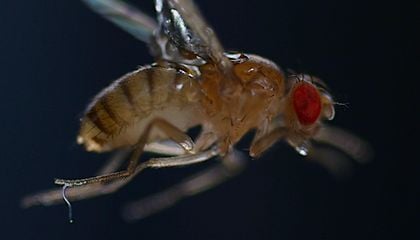Science
Nematodes Harness Static Electricity to Attach to Fruit Flies

Researchers at the University of California, Berkeley, have discovered an intriguing method by which nematodes, a type of parasitic worm, utilize static electricity to attach themselves to fruit flies. This groundbreaking study, published in 2023, unveils the remarkable capabilities of these tiny organisms and their ability to exploit environmental factors for survival.
The research focused on the behavior of nematodes as they interacted with their host, the fruit fly. Observing the dynamics of this relationship revealed that these worms can generate an electric charge through their movement. When they come into contact with a fly, the static electricity allows them to “hop” onto their host with remarkable efficiency. This interaction showcases an evolutionary adaptation that enhances the nematodes’ chances of reproduction and survival.
Mechanism Behind the Interaction
The study demonstrated that nematodes generate static electricity through the friction of their bodies against surfaces. When a fruit fly approaches, the nematodes can sense the electric field created by the fly. This sensory ability triggers the worms to launch themselves toward the fly, effectively securing their ride. This method of transportation is not only efficient but also minimizes the energy expended by the nematodes in searching for hosts.
Professor Robert Full, a leading researcher in the study, noted that these findings expand our understanding of how parasitic organisms adapt to their environments. “The ability to utilize static electricity for host attachment is a remarkable example of nature’s ingenuity,” he commented. This research opens avenues for further exploration into the interactions between parasites and their hosts, as well as potential applications in pest management.
Implications for Science and Industry
The implications of this research extend beyond the biological realm. Understanding how nematodes exploit static electricity could lead to innovative strategies in agriculture, particularly in managing pest populations. By developing methods to disrupt this attachment process, scientists may be able to reduce the impact of harmful pests on crops.
Moreover, the findings may inspire advancements in robotics and engineering. The mechanics of how nematodes effectively use environmental forces to enhance their mobility could inform the design of new robotic systems that mimic these natural processes. The fusion of biology and technology continues to provide exciting opportunities for innovation in various fields.
As researchers continue to delve into the complexities of parasitic relationships, the study of nematodes serves as a reminder of the intricate connections within ecosystems. The ability of these worms to harness static electricity is a testament to the adaptability of life and the ongoing quest for knowledge in the natural world.
-

 Health4 days ago
Health4 days agoRare Brain Condition Discovered More Common in New Mexico
-

 Politics5 days ago
Politics5 days agoPrince Andrew Steps Back from Royal Duties Following Epstein Memoir
-

 Health5 days ago
Health5 days agoRemembering Mary Ingleby: A Life of Love, Teaching, and Music
-

 Sports5 days ago
Sports5 days agoMLS Decision Day 2025: Playoff Spots on the Line as Teams Clash
-

 Science5 days ago
Science5 days agoIdaho State University Launches Haunted Science Laboratory on Oct. 25
-

 World5 days ago
World5 days agoYoung Driver Dies in Collision with Box Truck in El Cajon
-

 Lifestyle5 days ago
Lifestyle5 days agoKent Hamilton Named Southeastern Farmer of the Year at Expo
-

 Business5 days ago
Business5 days agoFirst National Bank of Groton’s Quiet Period Ends October 21
-

 Entertainment5 days ago
Entertainment5 days agoTrump Commutes George Santos’ Sentence, Sparks Controversy
-

 Politics5 days ago
Politics5 days agoNavy Veteran Max Quattromani Launches Campaign for Assessor Seat
-

 Sports5 days ago
Sports5 days agoSaquon Barkley Reacts to James Franklin’s Dismissal from Penn State
-

 World5 days ago
World5 days agoNevada Treasury Awards 2025 Kenny C. Guinn Memorial Scholarships









